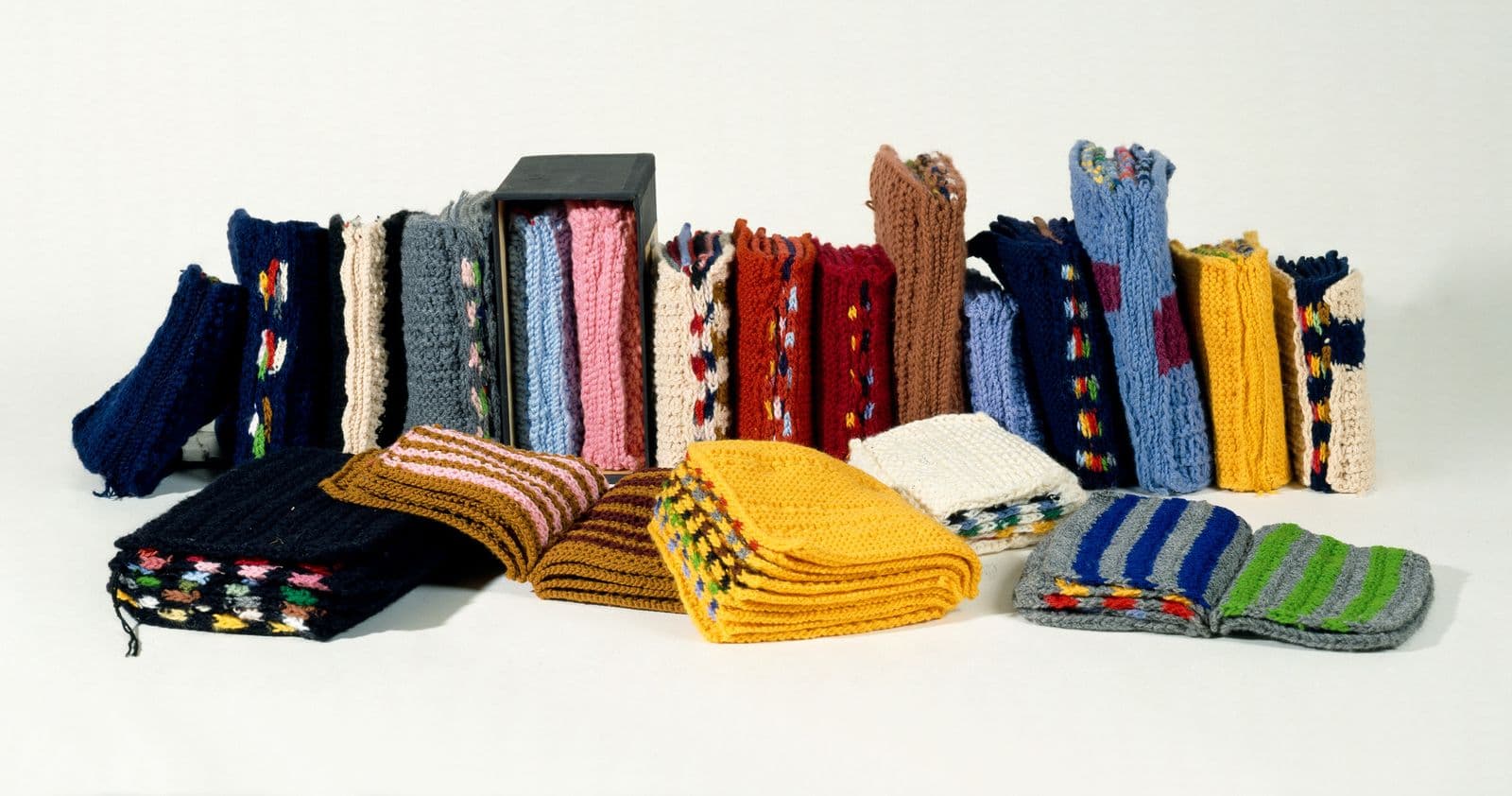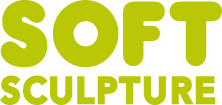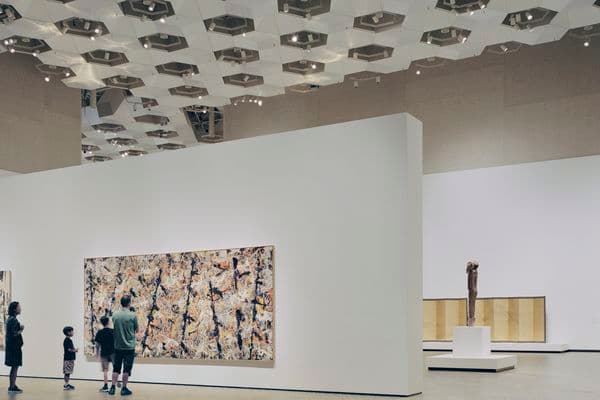Soft Sculpture
24 Apr – 12 Jul 2009

Jenny Christmann, 20 woollen books, 1977 - 1978, Gift of the Philip Morris Arts Grant 1982, © G.S. Christmann
About

Soft sculpture looks at the ways artists use unconventional materials to challenge the nature of sculpture. Visitors will see works made from cloth, rope, paper, hair, leather, rubber or vinyl. The objects may droop, ooze or splash. They are fluffy, squishy or bent. They surround, suffocate and astonish and, in many cases, make us laugh.
The exhibition features treasures from the national collection, complemented by some loans. It includes sculptures and installations by Eva Hesse, Robert Morris, Claes Oldenburg, Robert Rauschenberg, Joseph Beuys and Annette Messager, and works by Australian artists such as Mikala Dwyer, David Jensz and Ricky Swallow.
Exhibition Partners: Spooky Action at a Distance, New Acton, The Apartments
Sponsor circle: Zoo group, The Canberra Times, WIN network, Three Sides, Diamant hotels, Gallagher wines
Curatorial Essay
Plastics surround us. The foam in a chair is polyurethane. Drink bottles are polyethylene terephthalate. And keyboards are manufactured from acrylonitrile butadiene styrene. The science of contemporary life is bewildering. Our clothing is made of polyester and nylon, we eat with polystyrene cutlery from acrylic vessels and from polypropylene takeaway containers, and we live in buildings dominated by polycarbonates and polyvinyl chlorides. But if we concentrate on these substances and composites, with their seemingly endless number of applications, we may temporarily overlook the other common use of the term ‘plastic’: capable of being moulded or modelled, able to be influenced or formed.
Soft sculpture surveys the impact of unconventional materials on three-dimensional art practice over the last five decades. From the 1960s, artists began to use cloth, fur, rope, rubber, paper, leather, vinyl, plastics and other new substances to make forms that are persistent rather than permanent. The choice of these materials emphasises natural forces, such as gravity and heat, and in many cases have metaphorical or metaphysical implications. The exhibition examines the historical relationship between anti-form works of the 1960s and 1970s, and later categories of art, to the present day. It shows the many diverse ways artists exploit substances to make works of art.
Traditional sculpture is by definition dimensional and durable; it requires the determination of the artist. In the plastic arts, a distinction is made between painting’s appeal to the eye and sculpture’s references to the body, and, by extension, to our senses. Materials evoke certain sensations. Fur is a link to times when people relied on pelts for warmth and body covering. Felt likewise protects against the elements but, by the fact of its processing, is one step removed from fur, wool or hair; it retains the ‘memory’ of forms, be they the head in a hat or, in Man Ray’s The enigma of Isidore Ducasse 1920, something more mysterious.
Soft sculpture includes Surrealist and Pop art objects to suggest some of the precursors for anti-form tendencies. Associated with the Paris Surrealists from a young age, Meret Oppenheim’s reputation was made by a single piece. Squirrel 1969—like her famous Object 1936, also known as Breakfast in fur (The Museum of Modern Art, New York)—combines an everyday item with fur. A beer tankard, its handle transformed into a tail and capped with a head made of foam, this work is wickedly funny, puzzling and even somewhat macabre. Fur is, of course, pleasant to touch but repellent to the tongue. Beer quenches the thirst and fills the stomach. But, here, access to the golden amber is perversely blocked by the foam stopper. Oppenheim’s elevation of a humble object has its origins in the readymade tradition set in train by Marcel Duchamp, but she also draws on fairytale figures from her childhood and notions of fabulist transformations.
One of the foremost proponents of Pop art, Claes Oldenburg is credited as the creator of soft sculpture. Throughout the 1960s, he made oversized hamburgers and pieces of cake in vinyl stuffed with kapok, and miniature, collapsible canvas objects such as drum sets, which offer wry commentary on the dominance of fast food and mass culture. Oldenburg’s work marries the Surrealists’ absurdist disregard for scale and functionality with a Pop art fixation on the crassness of consumerism. His objects and sculptures are often issued in editions, thus echoing the mass production of the original items. For the Icebag series of sculptures, he combines fabric and moulded plastic sheet with a motorised mechanism to explore the impact of movement. Icebag—scale B 1971 initially appears as a playful, oversized object, but in motion it takes on human characteristics. At times, it is unpleasantly reminiscent of a prosthetic device, or mechanical lung, and the cap has an uncanny ability to follow the viewer around the room.
A familiar animal is omnipresent through the oeuvre of Les Kossatz. He takes sheep, one of the most potent vernacular symbols of Australia, and sets them in some unusual contexts, subjecting them to bizarre juxtapositions of recognisable objects. They lounge on chairs, fly through curtains, confront one another across a plaza, or tumble out of trapdoors and slide down shoots. The skin used for Sheep on a couch1972–73 retains its shape by virtue of a wire armature, giving the animal a taxidermist’s quality. Positioned as if for shearing, it is bound to a leather bench—the type often found in museums and other modernist architectural settings, or in a psychiatrist’s room but, here, fitted with cart-like wheels. Is this support to counter the indignity of the animal’s situation? A comment on farming practices? Or could it be an involved joke about the state of sculpture per se, propped up by institutional support but sunk in the mire below? Sheep on a couch encapsulates the different types of ‘soft’ found throughout the exhibition: the sheep’s wool, the pliable couch and the lack of stability implied by the half-wheels.
Joseph Beuys’s materials are emotionally and symbolically charged—by notions of alchemy, by history, by the artist’s own psyche. Ideas of redemption and transformation are crucial to Stripes from the house of the shaman 1964–72 1980. The lengths of felt leading up to and through the wooden portal suggest transition. As well as being a source of warmth and insulation, felt absorbs dirt, dust, fat, water and sound and is therefore quickly integrated into its environment. Elements such as copper, iron phosphate, sulphur and cinnabar also relate to concepts of art as a spiritual force, which can heal through the use of ritual. But these substances are dangerous in certain contexts, especially when ingested. The coats—one sealskin, the other wool—in Stripes from the house of the shaman allude to Beuys’s performances, his self-conception as a mediator between the earthly and spiritual worlds. The intense emotion, incorporation of myth and ritual and consistent use of particular materials and objects make his work one of the most powerful of the postwar period.
Other organic materials, such as jute and hemp fibres, preserve smells. These materials evoke movements of the 1970s and the revival of interest in craft traditions. Like Beuys, Ewa Pachucka’s creative processes suggest an element of redemption. It took the Feminist art movement and re-evaluation of categories of fine art in the late 1960s and early 1970s for textile traditions, such as knitting and weaving, to be considered appropriate vehicles for sculpture. The life-sized figures in Landscape and bodies 1972 emerge from apparently peaceful surrounds. Their anonymous slumber is emphasised by the over-all quality of the work, punctuated by the knots, stitching and other evidence of the artist’s hand. The sheer monumentality of Pachucka’s project proclaims the relevance and physicality of making; it asserts grand ideals of humans living in harmony with the environment as well as the artist’s own utopian socialist beliefs.
Soft sculpture includes large works that hang, glitter, drip or ooze, as well as installations into which we enter to be surrounded and suffused. Throughout the late 1960s and 1970s, as access to plastics and plastic technology increased, artists produced increasingly experimental work. Eva Hesse’s desire for latex and fibreglass, her attraction to the painterly qualities and subtle colours of liquid rubber, overcame her misgivings about the material’s intrinsic vulnerability over time. Each component of the elegiac, hybrid installation Contingent 1969—one of Hesse’s last major works before her death at the age of 34—is a large rectangular stretch of latex-covered cheesecloth embedded at each end in a translucent field of fibreglass. The combination of these materials sets up a distinct tension between rigidity and malleability, continuity and change.
Artists also exploit the performative in their work, incorporating chance into the decision-making process. Using materials as diverse as liquid polyester resin and pigmented foam, Richard Van Buren and Lynda Benglis worked by pouring, spilling, even flinging their materials, making sculptures that embrace seemingly accidental forms. Elsewhere, the application of heat or a temporary reversion to liquid state produces startling effects of collapsing, melting and disintegration.
One room of the exhibition has been fashioned into a boutique of artists’ multiples and small-scale sculpture. Here visitors will find objects that slump, bend or even bite. Other objects are fluffy, squishy or squeezed. The materials of some works are hard and unyielding but have been manipulated by the artist to imply liquidity and movement or to recall substances that are actually soft. There are cakes made of foam, books knitted from wool and a satchel that is not leather. There are objects whose forms are less easily defined; things that should definitely never ever be touched, licked or smelled. In other rooms, visitors will find sculptures that incorporate air, objects made with hair, the stuff of dreams and nightmares. Even the traditional materials of painting, oil and canvas, are recast as relief sculpture that simply won’t stay on the wall.
Boxes can be a metaphor for absence and loss, implying a sense of narrative or progression, for the act of discovery or even forbidden knowledge. Lucas Samaras’s partially opened, pin- and stone-encrusted box incorporates a sense of anticipation. It is a perverse thing, both attractive and repellent, visually seductive and implicitly violent. Box no 85 1973 seems to invite touch but, like a Venus flytrap or some poisonous insect, we should keep our distance. Another box, Sylvie Fleury’s Vital perfection 1993, lined with snow-white fur and stamped with gold upper-case lettering, suggests a branded, expensive fashion item, perhaps with an element of fetishism. Like Oppenheim, Fleury uses fur but, in the 1990s, hers is acrylic. Her objects and multimedia installation explore notions of gender, ambivalence and consumerism, and while Vital perfection hints at luxury and fulfilment, it is, ultimately, empty.
Lauren Berkowitz’s use of plastic relies on accumulation, repetition and an element of surprise. Many hundreds of carefully cleaned and arranged bottles, used newspapers and collected bags were the stuff of her 1994 exhibition Bags, bottles and newspapers. She reminds us of the prevalence of non-perishable materials and single-use objects in our lives, but also demonstrates the continuing importance of serial, anti-form and minimalist tendencies in the 1990s. Originally part of that exhibition, Bags 1994 is constructed from two walls of white plastic shopping bags over a suspended wire armature. It is solid yet ethereal, a space in which sound is muffled yet light may pass. While the installation initially seems to promise comfort and protection, once inside, the viewer becomes aware of the precious fragility of the space and of its claustrophobic, anxiety-inducing qualities. A traditional memento mori causes us to reflect on the passing of time but, in Bags, Berkowitz has extended these ideas to warn of the dangers of over-consumption.
Much of Annette Messager’s work has an element of play as well as a tendency to catalogue and to fragment. In Penetration 1993–94 we quite literally walk into a room of body parts. One hundred and one brightly coloured, sewn and stuffed fabric objects—intestines, hearts, lungs, spines and other internal organs—hang in a grid formation from the ceiling.
They are based on diagrams from a biology textbook but reproduced as stuffed toys. On the one hand, the work suggests a child’s mobile or a place to explore. On the other, we can find more sinister references to an abattoir or surgery. The lights dangling among the body parts illuminate the forms and draw attention to their irregularity, the roughness of the stitching and the apparently casual nature with which they are hung with wool. Messager is concerned with the ways in which sex and science make use of the body and how domestic skills are trivialised.
There is nothing of the stitched, homemade quality in Nell’s The perfect drip 1999. This massive, stylised droplet has the viscosity of oil, the mirror finish of a finely polished automobile. The fact that it is dripping from the ceiling is immediately disconcerting: is this a water leak or build up of moisture? Could it be coolant from the air-conditioning?
Or perhaps something even nastier still? Trapped in time, we wait for the drip to fall while knowing perfectly well that it can’t. The amorphous, slightly surreal and space-age quality of The perfect drip suggests origins in a computer-generated, action-packed sci-fi film. Its disturbing but comical contradictions are the sculptural equivalent of Salvador Dali’s soft watches in his painting The persistence of memory 1931 (The Museum of Modern Art, New York). Nell’s work reprises ideas raised by Surrealist and Pop art artists, but is also a fine example of fluidity achieved in material form.
Soft sculpture reveals the qualities of softness and plasticity in many ways and across a range of media: furry, pliable, visceral, even liquid. Inspired by organic and inorganic forms, artists have transformed sculpture, engaging new materials and developing new forms of making. The impact of plastics and other resinous substances on art practice is especially remarkable when we consider just how recent is their development. Indeed very little contemporary work is actually completely hard. Just as Rodin in the nineteenth century broke with traditional sculpture—and the invention of pre-mixed paints in portable tubes is a factor in the beginning of Modernism—the introduction of pliable, petroleum-based substances has had a major impact on art of the last 50 years.
Lucina Ward
Curator, International Painting and Sculpture
Text sourced from: Ward, Lucina. Soft Sculpture. Canberra: National Gallery of Australia, 2009.
Archived site
The original website for this exhibition was published in 2009 and has been archived for research purposes.











